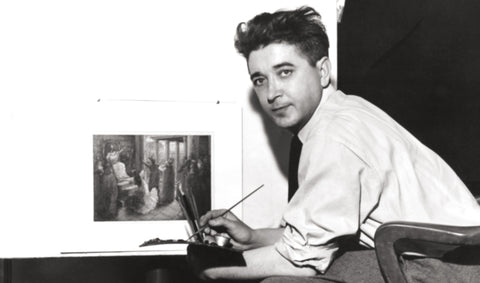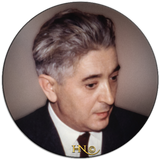Biography

Jacques Hnizdovsky, age 5, 1920 in Pylypcze, Ukraine
Jacques Hnizdovsky was born on January 27, 1915 in Ukraine during a time of great political upheaval, the collapse of Tsarist rule, and confiscation of land and Siberian exile for most of his family, for the sole reason of being titled landowners. Being away at boarding school at the time of great political turmoil, Jacques, the youngest of seven children, the child of his parents old age, was able to escape this fate, although as a result, at the age of 14, he would never see his family again.

Jacques Hnizdovsky's ID Card
Hnizdovsky received a scholarship to study art at the Academy of Fine Arts in Warsaw. In 1939, when Germany bombed Warsaw, the Academy of Fine Arts closed and Hnizdovsky was forced to flee Poland. He continued his studies at the Academy of Fine Arts in Zagreb, receiving credit for the two semesters he completed in Warsaw. He would graduate with honors and would complete two extra years of post-graduate studies at the Academy of Fine Arts in Zagreb. The Academy provided him with his own Master's Studio during his post-graduate studies.

Hnizdovsky at his Master's Studio at the Academy of Fine Arts, Zagreb
At the Academy of Fine Arts in Zagreb, Jacques worked from a human model, both in painting and in sculpture, and had an early interest in portraiture. Jacques Hnizdovsky was self-taught in printmaking, yet would come to be known as one of the world's most noted printmakers.

Jacques Hnizdovsky's painting of the Academy of Fine Arts, Zagreb
Upon graduation, with Europe in total disarray, Hnizdovsky found himself stateless, and in a displaced persons camp in Weyarn, Germany, where he patiently awaited sponsorship to be able to emigrate to the United States. Having lost everything during the war, Hnizdovsky arrived in the United States with nothing, yet was determined to overcome immense hardships to become an independent artist.

Hnizdovsky's quarters at the DP Camp in Weyarn, Germany

Jacques Hnizdovsky painting religious calendars for Brown & Bigelow
During the 1950s he experimented with different artistic media, working in oil, watercolor, tempera, pen and ink and terra-cotta, in addition to working on the prints for which he is best known. He started to develop the stylized realism that personified his work. His emphasis was always on harmony and capturing the essence of his subjects. This can best be seen in his animal prints, which exhibit a quiet humor.

Jacques Hnizdovsky's terra-cotta sculpture "Philosopher"
The 1950s were difficult years, but his plan was to be able to travel to France to paint. In Paris, he was to meet his future wife, partook in numerous exhibitions, including several one man shows, and participated in the Salon d’Automne du Grand Palais. Paris’ architecture, buildings, bridges, canals and precisely pruned trees made a great impression on the artist, and he was finally able to see his way out of the artistic and personal crisis he experienced during the 1950s.
In 1962 he was awarded the First Prize at the Boston Printmakers annual exhibition for his print “The Sheep”. "The Sheep" was to become his best-known and most successful print, selling out almost immediately.
Hnizdovsky was a master printmaker, creating woodcuts, linocuts and etchings. He created over 375 prints in his lifetime and just as many paintings, painting during the day, and working on his prints in the evenings. His skills as a printmaker was so great, that he was called upon to print editions for other artists.
In creating relief prints (woodcuts and linocuts), Hnizdovsky would use U- and V-shaped tools to gouge away the un-printing areas from the wood or linoleum blocks, leaving elevated areas that would receive and transfer the ink to the paper. Hnizdovsky also produced etchings (intaglio prints), where the design was scratched away (etched into) the resin-coated metal plate. (In etchings, the ink that was transferred to the print came from within the grooves rather than the from the surface.)

Jacques Hnizdovsky, Leafless Tree, woodcut, 1965
Larger woodcuts required weeks or months of intricate cutting before printing. Hnizdovsky would print five to ten trial proofs, refining each image, and then proceeded to print an edition of approximately 25 artist’s proofs. The final limited and numbered edition would contain between 100 to 150 prints. For his woodcuts and linocuts, Hnizdovsky favored washi, a Japanese paper that is hand made from mulberry bark. This fine, handmade paper is characterized by its irregularities and like raw silk, its beauty lies in its irregularity and inclusions, often pieces of bark or twigs.
Hnizdovsky focused on his love of nature, flora and fauna. He was inspired by Durer, by Japanese printmaking and by Chinese brush painting. Hnizdovsky’s striking style can be easily recognized by its harmonious blend of angular and curved lines, with textures developed by repetitions of patterns.
Hnizdovsky was invited to participate in the Contemporary U.S. Graphic Arts exhibition which traveled to the U.S.S.R. in 1963, as well as a similar exhibition to Japan in 1967. His woodcuts were included in the Triennale Internazionale della Xilographica in Italy in 1972. He had more than a hundred one-man exhibitions and participated in official American traveling exhibitions to the former Soviet Union, China and Japan.
In 1977 shows of his woodcuts were held at the Long Beach Museum of Art and Yale University, and in 1978 and 1982 at the University of Virginia and at the Hermitage Museum in 1981. (abridged list)
He received a Tiffany Fellowship in 1961, and fellowships from the following: MacDowell Colony in 1963, 1971, 1976, 1977; Yaddo Foundation in 1978; Ossabaw Foundation in 1980; Virginia Center for the Creative Arts in 1979, 1981, 1982, 1983, and 1984.
In 1975 a catalogue raisonné Hnizdovsky Woodcuts 1944-1975 was published by Pelican Publishing Company. In 1987 an updated version Jacques Hnizdovsky Woodcuts and Etchings was published, which includes all woodcuts, linocuts and etchings created during the artist's lifetime.
Another venue for Hnizdovsky’s art were book illustrations and book cover designs. Among many others, Hnizdovsky has contributed illustrations to The Poems of John Keats, 1964; The Poems of Samuel Taylor Coleridge, 1967; Tree Trails of Central Park, 1971; Flora Exotica, 1972; The Poems of Thomas Hardy, 1979; The Traveler’s Tree, 1980; The Poetry of Robert Frost, 1981; Signum Et Verbum, 1981; A Green Place, 1982; Birds and Beasts, 1990; Behind the King’s Kitchen, 1992; The Girl in Glass in 2002; and The Adventurous Gardener in 2005. The entire collection of book covers designed by Hnizdovsky and books illustrated by the late artist was donated to the Slavic and Baltic Division of the New York Public Library in 1986.
Hnizdovsky used the numerous small woodblocks that were left over from his larger prints to create what he called his “small woodcuts”, ex libris designs that he created for himself, collectors and institutions.
After Hnizdovsky's death, a large collection of pen-and-ink drawings and several watercolors were discovered hidden among his prints. His watercolors and pen and ink drawings were rarely exhibited. Many of the one-of-a-kind pen and ink drawings inspired woodcuts of the same subject.
Hnizdovsky also designed tapestries, which he commissioned to be hand-woven for him, of hand-shorn, hand-spun, naturally dyed wool.

Jacques Hnizdovsky, Hosta, pen and ink drawing
Hnizdovsky was recognized in the art world with numerous international awards, exhibitions and publications. He was one of the first artists invited to exhibit in China in the 1960s.
Among the numerous permanent collections with woodcuts by Hnizdovsky are: The Addison Gallery of American Art, Burnaby Art Gallery, Butler Institute of American Art, Chrysler Museum, Cleveland Museum of Fine Arts, Davison Art Center, Duke University Museum of Art, Dulin Gallery of Art, Hunt Institute for Botanical Documentation, Henry Art Gallery, University of Washington, Lauren Rogers Museum of Art, Louisiana Arts and Science Center, Louisiana State Museum, Minneapolis Institute of Arts, Mississippi Museum of Art, Museum of Fine Arts, Boston, National Museum of American Art, New Orleans Museum of Art, New York Public Library, Philadelphia Museum of Art, Tweed Museum of Art, The U.S. Information Agency, Library of Congress and White House, University of Delaware, Virginia Museum of Fine Arts, Winnipeg Art Gallery and Yale University. (abridged list)

Jacques Hnizdovsky, Washington Monument, woodcut, 1985
Jacques Hnizdovsky passed away in New York on November 8, 1985 at the age of 70, just days after printing his final woodcut, Washington Monument. He is buried at the historic Lychakivskiy Cemetery in Lviv, Ukraine.

Jacques Hnizdovsky, front left, in front of the tomb of Ivan Franko.
His gaze is fixed towards the location of his own final resting place.
